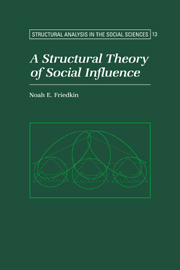1 - Social Structure and Social Control
Published online by Cambridge University Press: 23 December 2009
Summary
Abstract. Elucidating mechanisms by which actors in differentiated social positions come to be coordinated remains a key theoretical problem for structural analysis. The strength of structural analysis has been its success in describing complex patterns of social differentiation; its weakness has been that it is not wedded to a structural social psychology that elucidates how interpersonal agreements are formed in a complexly differentiated group. Hence, interpreting the revealed social structures has been difficult, especially with regard to their implications for social control.
Analysis of social structure has been advanced by the idea that social differentiation is defined by networks of social relations. Prior to the network approach to social structure, analysts relied on nominal classifications of actors (based on gender, race, ethnicity, religion, or occupation among other variables) to describe the social differentiation of groups, communities, and organizations. In the network approach to social structure, the positions of actors are revealed by their patterns of relations with other actors, and a differentiated social structure is defined by the existence of actors who occupy different positions in networks of social relations. The approach has been widely applied. For instance, it has been used to describe the social structure of elite families in Florence circa 1430, monks in a present-day monastery, major corporate actors in national markets and policy communities, and researchers in scientific specialties.
I build on this line of structural analysis. Social differentiation is my start point.
- Type
- Chapter
- Information
- A Structural Theory of Social Influence , pp. 3 - 22Publisher: Cambridge University PressPrint publication year: 1998

